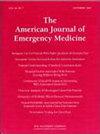伴有和不伴有乳酸酸中毒的酒精酮症酸中毒的临床特征:一项回顾性描述性研究
IF 2.7
3区 医学
Q1 EMERGENCY MEDICINE
引用次数: 0
摘要
酒精性酮症酸中毒(AKA)是一种潜在的危及生命的疾病,是由于慢性酒精使用引起的高阴离子间隙代谢性酸中毒。虽然乳酸性酸中毒(LA)在AKA中通常不常见,但没有并发急性疾病的AKA偶尔会合并LA。本研究的目的是阐明孤立的AKA患者合并LA和不合并LA的临床特征。方法回顾性研究于2021年1月至2024年1月在某三级医院进行。我们确定了年龄≥20岁的孤立AKA患者,他们表现为高阴离子间隙代谢性酸中毒,血清或尿液中酮类升高,以及酒精使用障碍。患者分为LA组(乳酸≥4 mmol/L)和无LA组。我们检查了两组患者的临床特征和结果,并分析了LA患者住院期间的乳酸趋势。结果在41例AKA患者中,33例(80%)患者发生LA,尽管两组患者的硫胺素水平相似。LA患者总酮体和β-羟基丁酸水平低于非LA患者。LA患者的乳酸水平中位数(10.7 mmol/L, IQR 7.7-14.5)在入院后的前6小时内每小时下降约1 mmol/L。没有患者在住院期间死亡。结论孤立性AKA易并发高乳酸血症。较高的乳酸水平倾向于在酮水平较低的病例中观察到。乳酸水平稳定下降。需要进一步的研究来证实我们的发现。本文章由计算机程序翻译,如有差异,请以英文原文为准。
Clinical features of alcoholic ketoacidosis with and without lactic acidosis: A retrospective descriptive study
Background
Alcoholic ketoacidosis (AKA) is a potentially life-threatening condition due to high anion gap metabolic acidosis in chronic alcohol use. While lactic acidosis (LA) is typically uncommon in AKA, AKA without concurrent acute conditions is occasionally complicated with LA. The aim of this study was to clarify the clinical features in isolated AKA patients with LA and those without LA.
Methods
This retrospective study was conducted at a tertiary hospital between January 2021 and January 2024. We identified isolated AKA patients aged ≥20 years who presented with high anion gap metabolic acidosis, elevated ketones in serum or urine, and alcohol use disorder. Patients were classified into those with LA (lactate ≥4 mmol/L) and those without LA. We examined the clinical characteristics and outcomes in both groups and analyzed lactate trends during hospitalization in patients with LA.
Results
Of 41 patients with AKA, 33 patients (80 %) had LA despite the fact that thiamine levels were similar in the two groups. Total ketone body and β-hydroxybutyrate levels in patients with LA were lower than those in patients without LA. Median lactate levels (10.7 mmol/L, IQR 7.7–14.5) in patients with LA decreased by approximately 1 mmol/L per hour during the first six hours post-admission. None of the patients died during hospitalization.
Conclusions
Isolated AKA is likely to be complicated with hyperlactatemia. Higher lactate levels tended to be observed in cases with lower ketone levels. Lactate levels in isolated AKA with LA declined steadily. Further studies are needed to confirm our findings.
求助全文
通过发布文献求助,成功后即可免费获取论文全文。
去求助
来源期刊
CiteScore
6.00
自引率
5.60%
发文量
730
审稿时长
42 days
期刊介绍:
A distinctive blend of practicality and scholarliness makes the American Journal of Emergency Medicine a key source for information on emergency medical care. Covering all activities concerned with emergency medicine, it is the journal to turn to for information to help increase the ability to understand, recognize and treat emergency conditions. Issues contain clinical articles, case reports, review articles, editorials, international notes, book reviews and more.

 求助内容:
求助内容: 应助结果提醒方式:
应助结果提醒方式:


